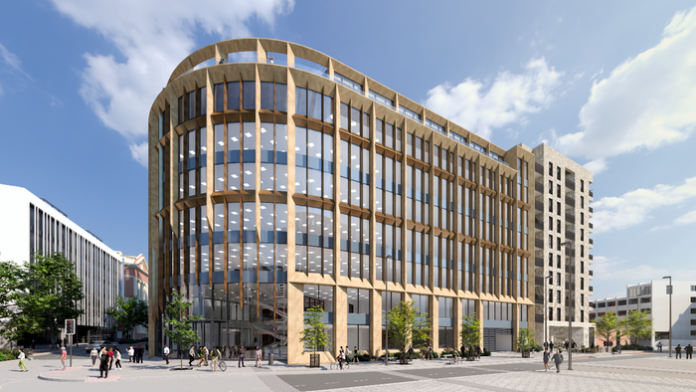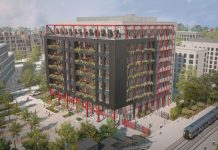A strong H1 for the Bristol office market demonstrated that, despite anxieties over the prospect of a downturn in the economy, tenants locally continue to remain calm and are carrying on with business as usual. Perhaps we shouldn’t be too surprised as the city’s office market (after briefly holding its breath) also remained unflustered over Brexit and Covid.
Q1 saw 234,275 sq ft of space changing hands in the city centre, the highest first-quarter take-up figures on record, with fast-growing fintech newcomer Paymentsense taking 54,767 sq ft at EQ and Deloitte a further 22,500 sq ft at Halo – both deals vindicating the confidence of their developers to press ahead with their schemes. A welter of smaller deals included 18 of 5,000 sq ft or less, with Desklodge representing the third biggest single transaction at 17,265 sq ft.
Q2 proved no less frenetic in terms of the number of transactions, with some 25 deals of 5,000 sq ft or less being chalked up, but the total amount let was down to a (still respectable) 143,609 sq ft.
The largest was Pax8, another newcomer to the city, taking 24,375 sq ft at No 2 The Distillery,and Runway East a further 16,442 at One Victoria Street. Added together, total take-up for the first half of 2022 was 377,884 sq ft against the five-year average of 290,000 sq ft.
The fact that the £40 psf rental barrier was broken not just once but three times in that period(and hit a new high water mark at £42.50 with Paymentsense’s deal at EQ) is highly significant for Bristol and will provide developers and landlords further encouragement to invest in the city.
From most tenants’ perspective, rents for the best quality space being at this level is not proving a barrier: property remains a small element in their business costs, and they see their workspace as far more than a roof over their employees’ heads. It is a vital HR tool, boosting their prospects of recruiting and retaining talented people as well as enhancing productivity.
CEOs increasingly recognise the value of quality accommodation to their business, particularly if the property can also tick all of the ESG boxes, and this is reflected in Grade B+ refurbished products currently achieving rents in the high £30s – a relatively small discount to brand new Grade A stock.
However, the two-tier second-hand market which we have seen emerging in recent years is becoming even more accentuated, with lower quality space stuck in the low £20s. That sort of differential is proving a real fillip to refurbishment. Those landlords with good kit find themselves with greater demand, and if they offer a degree of flexibility tenants will be prepared to pay for it.
Bristol continues to punch above its weight in the regional stakes, our tech and creative sectors especially. Good names continue to set up bases here: US-based Pax8 – one of Bristol’s five unicorn businesses (a privately held start-up company valued at over US$1billion) are a good example – while the arrival of Paymentsense also demonstrates how Bristol is attracting high profile TMT players. While the inward flow of businesses from London has stemmed slightly, talented employees themselves are continuing to move here because it is an attractive place to live and there are exciting companies to work for.
Above all, it’s the (very healthy) growth of indigenous companies primarily helping to explain the buoyant take-up figures: the legal sector in particular continues to expand, with Clarke Willmott taking 15,624 sq ft at Assembly C the largest of the deals struck by the profession in the first half.
On the supply side, a relatively healthy stock of 46,557 sq ft of Grade A new space is currently available, facilitating churn. Brand new Grade A Under construction is a further 491,000 sq ft– chiefly at EQ, Assembly B & C, and The Welcome Building (207,000 sq ft), all reaching practical completion during 2023.
Significant redevelopments underway total 194,262 sq ft and include the likes of North Quay House, One Hundred (formerly 100 Victoria Street) and BLOK (formerly One Castle Park),again all due to reach practical completion in 2023.
In total these schemes combined will represent well over half a million sq ft of ESG ready office space in the heart of Bristol city centre by Q4 2023.
When and what, though, will the next development cycle after that comprise?
There are a further eight new build, or redevelopment schemes with planning in place totalling 883,675 sq ft on the blocks… The question is do the appraisals still stack up against the backdrop of rising interest rates and construction costs.
That said, developer/landlord sentiment remains positive. They know that if they produce the right product they will get a tenant… and a good rent.
Prospective tenants looking to move in a hurry do need to know that the speed of deals is currently very slow, not least because of the additional due diligence now required. ESG also means more technical work, especially where fit outs need to be agreed, then undertaken and passed by landlords.
The out of town market enjoyed a good first half, even if the second quarter (46,614 sq ft)lagged behind the first (102,133 sq ft), and H1 ended fairly much in line with the five-year average. Q1 was the highest first quarter take-up since 2014.
The headline rent of £23 for good quality Grade B+ was maintained on the back of that, but it remains the fact that companies either want to be outside of the city centre or not, and that’s down to the type of business and the demographic of their employees, and the rental gap between the two markets is now as wide as it has ever been.
Another recent trend of interest in the Bristol market is the emergence of Cat A+ fit outs:technically defined as between a Cat A and Cat B fit out.
It represents a flexible approach being offered by some landlords (including Royal London,L&G, CEG and EPIC) to meet the demand from tenants for space that allows them to amortise the cost of a fit-out over the duration of their lease with a supplement on the rent, rather than having to find the funds to pay for the fit out themselves upfront.
In London, the market for Cat A+ space has increased rapidly in the last couple of years and accounts for some 20 million sq ft. It now promises to facilitate deals in the Bristol market.An increasing number of landlords are planning for prospective tenants to be able to view a choice of costed landlord designs on video fly-throughs accessed via QR codes.
Bristol’s serviced office sector continues to prosper post-Covid, with the existing providers around 85 to 90% full, leaving scope for one or even two more players to come into the market. Desklodge and Runway East accounted for two of H1’s biggest deals and WeWork is currently looking at options for 50,000 sq ft in the city. Their arrival could prove highly significant for Bristol as some US businesses will specifically seek out WeWork premises to gain a foothold in a new territory.
For developers looking to sell their product on, Bristol is now widely seen as the darling of the regional cities for UK institutional investors, and those investments that have come onto the market in the past few months have generated a good deal of interest and commanded healthy yields – typically around 5% for prime product.
Bristol’s Clean Air Zone is due to come into force this November: it is already having an impact on building specifications and will become increasingly relevant in the years ahead: expect a continued reduction in car parking places along with an increase in bike spaces. Looking further forward, the huge popularity of the GPS Regulated E-scooter is already playing a key role in moving people around the city, and this will only go from strength to strength when they can be owned rather than rented as part of a proposed Government change to the law.
The answer continues to be: Yes, with the right property which either has ESG in place or can be brought up to standard, or it can be purchased at the right price… because the market is only going one way. [Bristol is a market where the occupier has choices, appreciates a good quality product… and,importantly, is prepared to pay for it.
But if a building can’t be refurbished to those standards, or the cost would be too high, then caveat emptor.




















